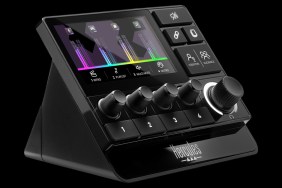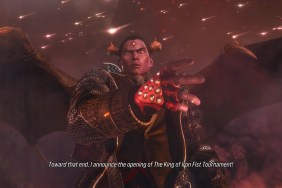Crouching Tiger, Hidden Control-Scheme.
I have a confession to make. This game confuses me. Like the cartoon and manga upon which the game is based, I don’t quite get it. I feel a bit like the 80-year-old who insists on calling Transformers “Transformerbots” or calling Pokémon “Pokey Mans”. The universe of Dragon Ball Z is far beyond my ken, and like other cosmic mysteries, I can only shrug my shoulders and resign myself to being forever in the dark. I’ll never know who or what a “dragon ball” is, and I have no idea what happened to dragon balls A through Y. (~Ed. Here’s what happened to ‘X’.)
[image1]What, then, am I doing reviewing a game based on Dragon Ball Z? I’m of the opinion that a well-made game is a well-made game, regardless of its origins. If you’re someone who assumes that any criticisms I might have comes from my inability to tell the difference between Son Goku and Son Gohan, you’d probably buy the game regardless of what I say. If, on the other hand, you’re like me and are a little curious about the game’s unique fighting gameplay, read on.
Like its immediate predecessors, Dragon Ball Z Budokai Tenkaichi 3 is distinctive from other fighting games. Don’t expect Tekken-style gameplay; this game has much more in common with old-school beat-‘em-ups like River City Ransom than arcade-style button mashers. And like those beat-‘em-ups of yore, Budokai Tenkaichi 3 also incorporates some role-playing elements. Characters gain status bonuses and items, and some modes even allow you to play turn-based mini-games that improve your stats further.
Budokai Tenkaichi 3 streamlines some of the non-fighting gameplay found in the prior entries in the series and focuses much more on the fighting itself. With all the excess fat trimmed off, the game can instead highlight its wide array of play modes. In “Dragon History”, you fight your way through a series of one-on-one arena battles that recreate key conflicts from the Dragon Ball saga. As the meat of the game, it’s the only place you’ll find anything resembling “story”.
In “Ultimate Battle,” you again fight your way through a series of one-on-one arena battles, only this time you fight in a battle simulator. That the simulator looks indistinguishable from the “real” world is only odd if you care about such details. In “Dragon World Tour”, you yet again fight your way through a series of one-on-one battles, but the difference this time is that you fight in a single-elimination tournament. There’s an audience watching you fight, but otherwise it plays identically to the other modes.
[image2]As you can probably guess, each mode is basically the same thing over again with minor tweaks. I could convince myself that “sitting on my ass all day” is actually “important self-reflection”, but I doubt anyone would fall for it. Same thing here. One-on-one fights are still one-on-one fights, and no amount of tournament spectators or battle simulators changes that.
“Duel” mode presents a slightly bigger departure from other modes since you can fight against a real opponent, a computer opponent, or watch two computer opponents beat each other up. Watching two computer dudes vying for victory is about as exciting as watching laundry dry itself on the clothesline, but if you’re hard up for things to do, I suppose you could do worse. Combining the two is much more entertaining.
The fighting gameplay itself is a refreshing take on an aging genre. Instead of just walloping on your opponent in close quarters, you can also fly around the enormous arenas and fire energy bolts at each other. And while almost every playable character controls the exact same way, there are enough different moves to make things interesting.
Learning the all the intricacies of the controls, however, will take newcomers to the series a long time to learn. Because the game departs from so many conventions of the fighting genre, the button combinations aren’t intuitive or obvious. Even on the easiest difficulty setting, expect to lose often if you’ve never spent time with the series. The learning curve is absurdly steep, so be ready to chow down on humble pie for a while. And the tutorial isn’t much help either, since it reads like a technical manual written in abugida.
[image3]While the standard PS2 controls are hard enough to manage, the Wii version gives you the chance to play using the Wii remote and nunchuck, a Gamecube controller, or the classic controller. Using the Wii remote only adds to the complexity of an already over-complicated control scheme, so avoid the remote if you’ve got either of the alternatives handy. Trying to waggle while you reach for the directional pad and one of the number buttons isn’t impossible, but then neither is rocket science.
If you can’t get the controls down, fear not; most people can’t either. In multiplayer, you’ll have the chance to play against similarly confused people. On PS2, multiplayer is local-only, so you’ll have to find someone nearby who also has trouble with the controls. Maybe if grandpa’s not too busy, you can invite him over for his first fair fight in decades.
On Wii, you have the chance to take your (complete lack of) skills online and see if you’re the only one who can’t figure out the crazy control scheme. In my online matches, I had much better luck against human opponents than I did against the computer opponents in the single-player modes. Getting online and finding a match was easy and required no pesky friend codes. Unfortunately, all my matches suffered from varying degrees of game-breaking lag. Yes, it evened the odds a bit since both of us were in the same lag-filled boat, but that didn’t stop the boat from sinking.
[image4]Not all is lost, though. The graphics are colorful and suitably cartoon-like. Character animations are smooth, even if they’re also severely limited in variety. Furthering the animated feel, game menus are full of talking characters and rockin’ anime guitar tracks. Elsewhere, though, the vibrant cartoon sensibility falls apart. In particular, the sound effects and voice work in the battles themselves sound like they were recorded in a tiny metal box. The sound quality in the game menus is fine, but the battle effects sound thinner than my excuses for not going home for Thanksgiving.
I have a hard time justifying a game as “for fans only”. Niche games will sell to their respective audiences regardless of what I say. For the rest of you, Dragon Ball Z Budokai Tenkaichi 3’s title alone will probably convince you to steer clear. For the morbidly curious, however, the game does offer a glimpse at what an unconventional fighting game might look like. I can respect Funimation’s attempt to change many staid fighting game conventions throughout their Dragon Ball Z Budokai Tenkaichi series, but in the process, the controls have become almost impossible to learn. Control-wise, the game expects you to learn how to fly before you’ve even learned to walk. For fans of the cartoon, stick to your dubs and leave the game to less discriminating DBZ fans.
-
Unique fighting game
-
Dragon-sized content
-
Frustrating learning curve
-
Variety isn't so varied
-
Crazy control scheme
-
Wii's online mode needs lag-proofing











